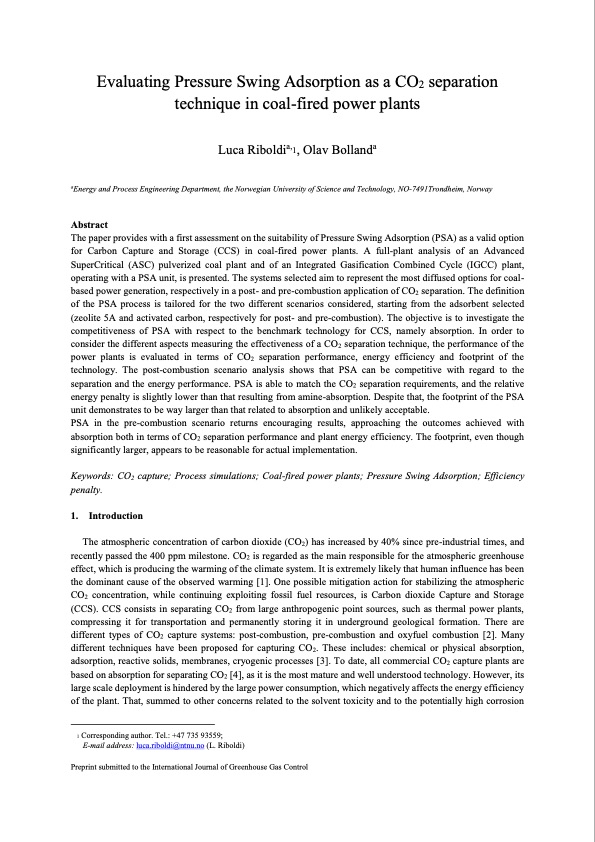
PDF Publication Title:
Text from PDF Page: 001
Evaluating Pressure Swing Adsorption as a CO2 separation technique in coal-fired power plants Luca Riboldia,1, Olav Bollanda aEnergy and Process Engineering Department, the Norwegian University of Science and Technology, NO-7491Trondheim, Norway Abstract The paper provides with a first assessment on the suitability of Pressure Swing Adsorption (PSA) as a valid option for Carbon Capture and Storage (CCS) in coal-fired power plants. A full-plant analysis of an Advanced SuperCritical (ASC) pulverized coal plant and of an Integrated Gasification Combined Cycle (IGCC) plant, operating with a PSA unit, is presented. The systems selected aim to represent the most diffused options for coal- based power generation, respectively in a post- and pre-combustion application of CO2 separation. The definition of the PSA process is tailored for the two different scenarios considered, starting from the adsorbent selected (zeolite 5A and activated carbon, respectively for post- and pre-combustion). The objective is to investigate the competitiveness of PSA with respect to the benchmark technology for CCS, namely absorption. In order to consider the different aspects measuring the effectiveness of a CO2 separation technique, the performance of the power plants is evaluated in terms of CO2 separation performance, energy efficiency and footprint of the technology. The post-combustion scenario analysis shows that PSA can be competitive with regard to the separation and the energy performance. PSA is able to match the CO2 separation requirements, and the relative energy penalty is slightly lower than that resulting from amine-absorption. Despite that, the footprint of the PSA unit demonstrates to be way larger than that related to absorption and unlikely acceptable. PSA in the pre-combustion scenario returns encouraging results, approaching the outcomes achieved with absorption both in terms of CO2 separation performance and plant energy efficiency. The footprint, even though significantly larger, appears to be reasonable for actual implementation. Keywords: CO2 capture; Process simulations; Coal-fired power plants; Pressure Swing Adsorption; Efficiency penalty. 1. Introduction The atmospheric concentration of carbon dioxide (CO2) has increased by 40% since pre-industrial times, and recently passed the 400 ppm milestone. CO2 is regarded as the main responsible for the atmospheric greenhouse effect, which is producing the warming of the climate system. It is extremely likely that human influence has been the dominant cause of the observed warming [1]. One possible mitigation action for stabilizing the atmospheric CO2 concentration, while continuing exploiting fossil fuel resources, is Carbon dioxide Capture and Storage (CCS). CCS consists in separating CO2 from large anthropogenic point sources, such as thermal power plants, compressing it for transportation and permanently storing it in underground geological formation. There are different types of CO2 capture systems: post-combustion, pre-combustion and oxyfuel combustion [2]. Many different techniques have been proposed for capturing CO2. These includes: chemical or physical absorption, adsorption, reactive solids, membranes, cryogenic processes [3]. To date, all commercial CO2 capture plants are based on absorption for separating CO2 [4], as it is the most mature and well understood technology. However, its large scale deployment is hindered by the large power consumption, which negatively affects the energy efficiency of the plant. That, summed to other concerns related to the solvent toxicity and to the potentially high corrosion 1 Corresponding author. Tel.: +47 735 93559; E-mail address: luca.riboldi@ntnu.no (L. Riboldi) Preprint submitted to the International Journal of Greenhouse Gas ControlPDF Image | Evaluating Pressure Swing Adsorption as a CO2 separation technique in coal-fired

PDF Search Title:
Evaluating Pressure Swing Adsorption as a CO2 separation technique in coal-firedOriginal File Name Searched:
PSA-coal-fired-plants.pdfDIY PDF Search: Google It | Yahoo | Bing
CO2 Organic Rankine Cycle Experimenter Platform The supercritical CO2 phase change system is both a heat pump and organic rankine cycle which can be used for those purposes and as a supercritical extractor for advanced subcritical and supercritical extraction technology. Uses include producing nanoparticles, precious metal CO2 extraction, lithium battery recycling, and other applications... More Info
Heat Pumps CO2 ORC Heat Pump System Platform More Info
| CONTACT TEL: 608-238-6001 Email: greg@infinityturbine.com | RSS | AMP |